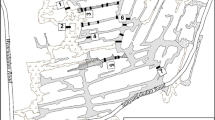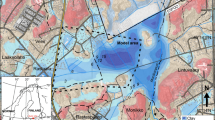Abstract
Wetlands in the Mississippi River Delta Plain (MRDP) have been suffering from a high rate of land loss. Sediment cores have been drilled into the wetlands to understand their growth and degradation and to provide subsurface information for the coastal protection and restoration projects. However, few three-dimensional (3D) stratigraphy models have been developed for the wetlands on a regional scale, due to difficulties in correlating large amount of spatial scattered subsurface data and integrated visualization of stratigraphic features and topobathymetric features. In this study, a 3D model was constructed in the Lower Barataria Bay (LBB) and the Lower Breton Sound (LBS), covering an area of 190 km2 and extending from 0.5 to − 4 m in elevation. Sediment composition (sand%, silt%, and clay%) was spatially interpolated, using a compositional kriging method, extended from ordinary kriging by a log-ratio transformation. Instead of visualizing three composition components independently, sediment composition was translated into sediment texture to be visualized as sediment types. Modeling results intuitively show spatial distribution of stratigraphic features and their spatial relationships with topobathymetric features such as marsh surface, river channel, and dredging channels. Results show a silty depositional package, which consists of crevasse splays and periodic overbank flooding deposits, made up the largest portion of the wetlands. A clayey blanket is observed to cover most part of the LBB and landward side of the LBS. A large area of clayey blanket in the seaward part of the LBS has apparently been eroded away, which is likely caused by coastal reworking processes.










Similar content being viewed by others
References
Allison MA, Yuill BT, Meselhe EA, Marsh JK, Kolker AS, Ameen AD (2017) Observational and numerical particle tracking to examine sediment dynamics in a Mississippi River delta diversion. Estuar Coast Shelf Sci 194:97–108. https://doi.org/10.1016/j.ecss.2017.06.004
Aquaveo LLC (2017) Groundwater modeling system 10.2. Aquaveo LLC, Provo, Utah
Ayachit U (2015) The ParaView guide: a parallel visualization application. Kitware, New York
Baldwin AH, Hammerschlag RS, Cahoon DR (2019) Chapter 25 - evaluating restored tidal freshwater wetlands. In: Perillo GME, Wolanski E, Cahoon DR, Hopkinson CS (eds) Coastal wetlands. Elsevier, pp 889–912. https://doi.org/10.1016/B978-0-444-63893-9.00025-3
Barras JA., Bernier JC, Morton RA (2008) Land area change in coastal Louisiana, a multidecadal perspective (from 1956 to 2006). U.S. Geological Survey Scientific Investigations Map 3019, scale 1:250,000, 14 p. pamphlet
Baumann NR, Day JW, Miller CA (1984) Mississippi deltaic wetland survival: sedimentation versus coastal submergence. Science 224:1093–1095. https://doi.org/10.1126/science.224.4653.1093
Blum MD, Roberts HH (2009) Drowning of the Mississippi Delta due to insufficient sediment supply and global sea-level rise. Nat Geosci 2:488–491. https://doi.org/10.1038/ngeo553
Bomer EJ, Bentley SJ, Crawford F, Hughes JET, Wilson CA, Xu K (2019) Deltaic morphodynamics and stratigraphic evolution of middle Barataria Bay and middle Breton sound regions, Louisiana, USA: Implications for River-Sediment Diversions. Estuarine, Coastal, and Shelf Science. https://doi.org/10.1016/j.ecss.2019.03.017. (In press)
Cahoon DR, Reed DJ, Day JW (1995) Estimating shallow subsidence in microtidal salt marshes of the southeastern United States: Kaye and Barghoorn revisited. Mar Geol 128:1–9. https://doi.org/10.1016/0025-3227(95)00087-F
Chamberlain EL, Törnqvist TE, Shen Z, Mauz B, Wallinga J (2018) Anatomy of Mississippi Delta growth and its implications for coastal restoration. Sci Adv 4:eaar4740. https://doi.org/10.1126/sciadv.aar4740
Coastal Protection and Restoration Authority of Louisiana (2012) Louisiana’s comprehensive master plan for a sustainable coast. In: CPRA. Baton Rouge
Coastal Protection and Restoration Authority of Louisiana (2013a) Lower Barataria sediment diversion. In: Diversion Project Handout. CPRA, Baton Rouge
Coastal Protection and Restoration Authority of Louisiana (2013b) Lower Breton sediment diversion. In: Diversion Project Handout. CPRA, Baton Rouge
Coastal Protection and Restoration Authority of Louisiana (2017) Louisiana’s comprehensive master plan for a sustainable coast. CPRA, Baton Rouge
Coleman JM, Gagliano SM (1964) Cyclic sedimentation in the Mississippi River deltaic plain. Gulf Coast Association of Geological. Soc Trans 14:67–80
Coleman JM, Roberts HH, Gregory WS (1998) Mississippi River Delta: an overview. J Coast Res 14:699–716. https://doi.org/10.2307/4298830
Couvillion BR, Barras JA, Steyer GD, Sleavin W, Fischer M, Beck H, Trahan N, Griffin B, Heckman D (2011) Land area change in coastal Louisiana (1932 to 2010). U.S. Geological Survey Scientific Investigations Map, p 3164
Couvillion BR, Beck H, Schoolmaster D, Fischer M (2017) Land Area Change in Coastal Louisiana (1932 to 2016). Scientific Investigations Map. U.S. Geological Survey Scientific Investigations Map 3381, 16 p. pamphlet, https://doi.org/10.3133/sim3381
Day JW, Britsch LD, Hawes SR, Shaffer GP, Reed DJ, Cahoon D (2000) Pattern and process of land loss in the Mississippi Delta: a spatial and temporal analysis of wetland habitat change. Estuaries 23:425–438. https://doi.org/10.2307/1353136
Day JW, Boesch DF, Clairain EJ, Kemp GP, Laska SB, Mitsch WJ, Orth K, Mashriqui H, Reed DJ, Shabman L, Simenstad CA, Streever BJ, Twilley RR, Watson CC, Wells JT, Whigham DF (2007) Restoration of the Mississippi Delta: lessons from hurricanes Katrina and Rita. Science 315:1679–1684. https://doi.org/10.1126/science.1137030
Esposito CR, Shen Z, Törnqvist TE, Marshak J, White C (2017) Efficient retention of mud drives land building on the Mississippi Delta plain. Earth Surf Dyn 5:387–397. https://doi.org/10.5194/esurf-5-387-2017
Fisk HN (1961) Bar-finger sands of the Mississippi delta. In: Peterson JA, Osmond JC (eds) Geometry of sandstone bodies. American Association of Petroleum Geologists, Tulsa, pp 22–52
Fisk HN, McFarlan E Jr, Kolb CR, Wilbert LJ Jr (1954) Sedimentary framework of the modern Mississippi delta. J Sediment Res 24:76–79
Frazier DE (1967) Recent deltaic deposits of the Mississippi River: their development and chronology. Transactions – Gulf Coast Association of Geological. Societies 17:287–315
Gagliano SM, Meyer-Arendt KJ, Wicker KM (1981) Land loss in the Mississippi River deltaic plain. Trans Gulf Coast Assoc Geol Soc 31:295–300
Georgiou IY, FitzGerald DM, Stone GW (2005) The impact of physical processes along the Louisiana voast. J Coast Res 44:72–89. https://doi.org/10.2307/25737050
Johnson C, Chen Q, Karimpour A, Bentley SJ, White C, Xu K, Wang J (2015) Geological and geotechnical characterization of coastal marshes in the Mississppi River Delta. In: Proceedings of the coastal sediments 2015
Krumbein WC, Aberdeen EJ (1937) The sediments of Barataria Bay [Louisiana]. J Sediment Res 7:3–17
Leonardi N, Carnacina I, Donatelli C, Ganju NK, Plater AJ, Schuerch M, Temmerman S (2018) Dynamic interactions between coastal storms and salt marshes: a review. Geomorphology 301:92–107. https://doi.org/10.1016/j.geomorph.2017.11.001
Love M, Amante C, Eakins B, Taylor L (2010) Digital elevation models of New Orleans, Louisiana: procedures, data sources and analysis, report, 44 pp. National Geophysical Data Center, Marine Geology and Geophysics division, Boulder
Morton RA, Bernier JC, Barras JA, Ferina NF (2005) Rapid subsidence and historical wetland loss in the Mississippi Delta plain: likely causes and future implications. Open File Report 2005–1216. U. S. Geological Survey
Olea RA (1999) Geostatistics for engineers and earth scientists. Kluwer Academic Publishers, London
Olea RA, Pawlowsky V, Davis JC (1993) Volumetric calculations in an oil field: the basis method. Comput Geosci 19:1517–1527. https://doi.org/10.1016/0098-3004(93)90065-D
Pawlowsky V, Olea RA, Davis JC (1994) Additive logratio estimation of regionalized compositional data: an application to calculation of oil reserves. In: Dimitrakopoulos R (ed) Geostatistics for the next century: an international forum in honour of Michel David’s contribution to geostatistics, Montreal, 1993. Springer Netherlands, Dordrecht, pp 371–382
Pawlowsky V, Olea R, Davis J (1995) Estimation of regionalized compositions: a comparison of three methods. Math Geol 27:105–127. https://doi.org/10.1007/BF02083570
Reed DJ (2002) Sea-level rise and coastal marsh sustainability: geological and ecological factors in the Mississippi Delta plain. Geomorphology 48:233–243. https://doi.org/10.1016/S0169-555X(02)00183-6
Roberts HH (1997) Dynamic changes of the holocene Mississippi River delta plain: the delta cycle. J Coast Res 13:605–627. https://doi.org/10.2307/4298659
Rozas LP, Minello TJ (2001) Marsh terracing as a wetland restoration tool for creating fishery habitat. Wetlands 21:327–341
Sha X, Xu K, Bentley SJ, Robichaux PA (2018) Characterization and modeling of sediment settling, consolidation, and suspension to optimize coastal Louisiana restoration. Estuar Coast Shelf Sci 203:137–147. https://doi.org/10.1016/j.ecss.2018.02.008
Shen Z, Törnqvist TE, Mauz B, Chamberlain EL, Nijhuis AG, Sandoval L (2015) Episodic overbank deposition as a dominant mechanism of floodplain and delta-plain aggradation. Geology 43:875–878. https://doi.org/10.1130/g36847.1
Smith JE, Bentley SJ, Snedden GA, White C (2015) What role do hurricanes play in sediment delivery to Subsiding River deltas? Sci Rep 5:17582. https://doi.org/10.1038/srep17582
Soil Survey Division Staff (1993) Soil survey manual. U. S. Department of Agriculture
Tolosana-Delgado R (2008) Compositional data analysis in a nutshell. University of Gottingen on-line reference. http://www.sediment.uni-goettingen.de/staff/tolosana/extra/CoDaNutshell.pdf
Törnqvist TE, van Ree MHM, van 't Veer R, van Geel B (1998) Improving methodology for high-resolution reconstruction of sea-level rise and neotectonics by paleoecological analysis and AMS 14C dating of basal peats. Quat Res 49:72–85. https://doi.org/10.1006/qres.1997.1938
Törnqvist TE, Wallace DJ, Storms JEA, Wallinga J, van Dam RL, Blaauw M, Derksen MS, Klerks CJW, Meijneken C, Snijders EMA (2008) Mississippi Delta subsidence primarily caused by compaction of Holocene strata. Nat Geosci 1:173–176
Turner RE (1997) Wetland loss in the northern Gulf of Mexico: multiple working hypotheses. Estuaries 20(1):13. https://doi.org/10.2307/1352716
van den Boogaart KG, Tolosana-Delgado R (2008) “Compositions”: a unified R package to analyze compositional data. Comput Geosci 34:320–338. https://doi.org/10.1016/j.cageo.2006.11.017
Walvoort DJ, de Gruijter JJ (2001) Compositional kriging: a spatial interpolation method for compositional data. Math Geol 33:951–966. https://doi.org/10.1023/A:1012250107121
Wang J (2018) Natural and anthropogenic impacts on sediment dynamics and preservation in contrasting Mississippi deltaic coastal environments. Dissertation, Louisiana State University
White CM (2017) Influences of hurricanes, floods, and organic production on river-delta evolution over decadal to centennial time-scales. Dissertation, Louisiana State University
Xu K, Bentley SJ, Robichaux P, Sha X, Yang H (2016a) Implications of texture and erodibility for sediment retention in receiving basins of coastal Louisiana diversions. Water 8:26
Xu K, Mickey RC, Chen Q, Harris CK, Hetland RD, Hu K, Wang J (2016b) Shelf sediment transport during hurricanes Katrina and Rita. Comput Geosci 90:24–39. https://doi.org/10.1016/j.cageo.2015.10.009
Yuill BT, Khadka AK, Pereira J, Allison MA, Meselhe EA (2016) Morphodynamics of the erosional phase of crevasse-splay evolution and implications for river sediment diversion function. Geomorphology 259:12–29. https://doi.org/10.1016/j.geomorph.2016.02.005
Acknowledgments
We acknowledge Cody Johnson for help with data compilation, and Jeff Bomer for sharing knowledge in the adjacent study area and providing suggestions.
Funding
This study was supported in part by the U.S. Geological Survey (Grant No. G16AP00056) through the Louisiana Water Resources Research Institute and by the Department of the Treasury under the Resources and Ecosystems Sustainability, Tourist Opportunities, and Revived Economies of the Gulf Coast States Act of 2012 (RESTORE Act) (Award No. RCEGR260003-01-00) through The Water Institute of the Gulf. This project was also funded by the Louisiana Coastal Protection and Restoration Authority through The Water Institute of the Gulf under project award numbers CPRA-2013-T11-SB02-DR, CPRA-2013-TO15-SB02-MA and CPRA-2013-TO16-SB02-MA. The statements, findings, conclusions, and recommendations are those of the authors and do not necessarily reflect the views of the Department of Interior and the Department of the Treasury.
Author information
Authors and Affiliations
Corresponding author
Additional information
Publisher’s note
Springer Nature remains neutral with regard to jurisdictional claims in published maps and institutional affiliations.
Rights and permissions
About this article
Cite this article
Li, A., Tsai, F.TC., Xu, K. et al. Modeling sediment texture of river-deltaic wetlands in the Lower Barataria Bay and Lower Breton Sound, Louisiana, USA. Geo-Mar Lett 39, 161–173 (2019). https://doi.org/10.1007/s00367-019-00566-2
Received:
Accepted:
Published:
Issue Date:
DOI: https://doi.org/10.1007/s00367-019-00566-2




